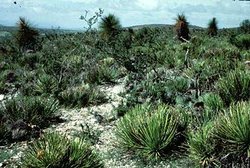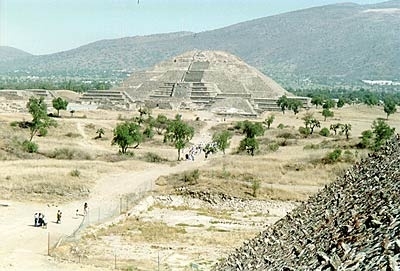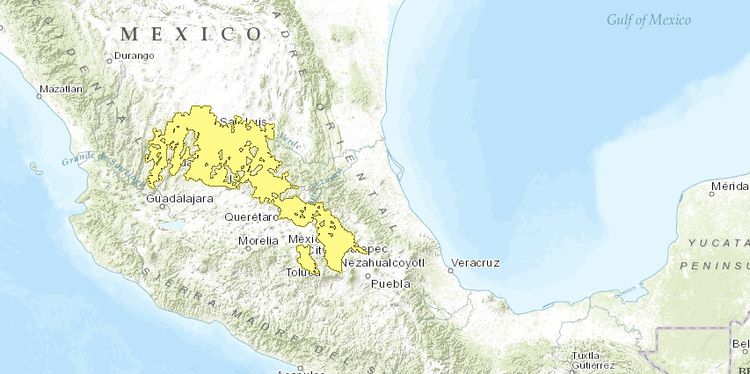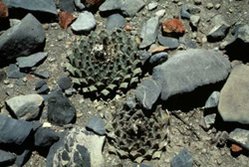Central Mexican matorral
 East of Machuala, Mexico Source: Source: WWF/ Edward Anderson)
East of Machuala, Mexico Source: Source: WWF/ Edward Anderson) Introduction
Much like the isolated montane (Central Mexican matorral) habitats it separates, this arid lowland plain is isolated by the immense mountain ranges of the Sierra Madres. Characteristically xeric habitats in Mexico are more diverse than any other habitat type. This Mesteta Central Matorral xeric shrubland is no exception, with 16 endemic genera of woody plant just as an example.
Location and General Description
Located in central Mexico, this region is surrounded by the Sierra Madre Occidental Mountains on the west, by the Sierra Madre Oriental Mountains in the east, and by the rugged Trans-volcanic belt to the south. The region constitutes the central portion of the Mexican Meseta Central, an extensive portion of flatlands occurring in north-central Mexico. The region is dominated by desert plains, with a few hills and mountains that rise up to 2400 meters (m) above sea level. The great majority of the substrate on which this scrub ecosystem grows is of sedimentary origin, and is composed of pure sedimentary rocks and some metamorphic elements (which are the result of volcanic activity in the tertiary). However, some areas that are nearer the Sierra Madre Oriental and Occidental Mountains also have soils of volcanic origin. The climate is dry and hot, with precipitation levels below 500 millimeters (mm) per year.
The plant associations are as variable as the specific conditions of the soil, temperature and exposure in slopes or valleys. The dominant species are Yucca filifera, Yucca carnerosana, Yucca decipiens and Larrea tridentata. Other species that can be found are Acacia farnesiana, Bouteloua gracilis, Echinocactus horizonthalonius, Echinocereus conglomeratus, Jatropha dioica, Mimosa zygophylla, Opuntia engelmannii, Prosopis juliflora and Tridens pilosus. The most common plant association in the northern portion of the region, near the Chihuahuan desert is between the Flourensia and Larrea. In areas of shallow soil, the scrub is characterized by plants with elongated leaves. In the states of San Luis Potosí and Zacatecas, the most common associations contain lechuguilla (Agave lechuguilla), Agave falcata, Bouteloua curtipendula, Bouteloua trifida, Dalea nana, Dasylirion cedrosanum, Ferocactus pringlei, Fouquieria splendens and Opuntia imbricata, and many others. On the tallest points in the sierra, this scrub is also associated to various species of Acacia, Cassia, and Leucophyllum. On the slopes of the two sierras flanking this region, on top of riolitic substrate, a scrub composed of Opuntia and Prosopis, with Yucca and Acacia grows in Zacatecas and southwest San Luis Potosí.
Biodiversity Features
The Meseta Central matorral ecoregion is one of the most extensive floristic and physiographic provinces of Mexico, and is a region where past geological events have promoted the diversification of the biota. This region was isolated from other arid regions in Mexico in the past. Orogenic activity fragmented the Meseta Central and the surrounding areas (that now constitute three of the most important mountain ranges of Mexico). The subsequent isolation of the region favored the differentiation and evolution of endemic species in each of the fragmented portions, therefore the matorral of the Meseta Central is characterized by its high content of endemic species. At least 16 endemic genera of woody plants and cacti have been described from this province (e.g. Dasylirion, Eutetras, Sartwellia, Ariocarpus, and Lophophora).
In terms of the herpetofauna, this region is considered among the richest zones of México; it is also a region of high levels of reptile endemism. In terms of the avifauna, arid regions of México are considered the richest in endemic species such as greater roadrunner (Geococcyx californianus), scaled quail (Callipepla squmata), spotted owl (Strix occidentalis), golden eagle (Aquila chrysaetos canadensis), great horned owl (Bubo virginiana), peregrine falcon (Falco peregrinus), red-tailed hawk (Buteo jamaicensis) and Worthen’s sparrow (Spizella wortheni).
It also houses mammal populations including yellow-faced pocket gopher (Orthogeomys spp.), Coyote (Canis latrans), Saussure’s shrew (Sorex saussurei) and the highly endangered Mexican prairie dog (Cynomys mexicanus). The vertebrate fauna of this region is comprised of 248 species that are endemic to Mesoamérica, of which 20 are critically endangered. Ecologically, pollination (Pollen) processes in this and other arid regions are highly specialized, resulting in species of plants and pollinators that have coevolved (Evolution) and that are now codependent. This dependence can be so extreme, that the reproductive patterns of some Agave species have become synchronized with the time of migration of their pollinating bats from Central America to North America, during spring and summer.
Current Status
The matorral of central Mexico has been partially eliminated, although some areas in the northern portion, (near the southern limit between the Chihuahuan desert and this region) are relatively intact. However, most of the region is altered and does not contain the original biota’s that characterize the southernmost portions of the Chihuahuan desert, of which this region is derived. There is a good system of protected areas which preserve this region; at least four areas have been established, and four more have been proposed. However, the biggest challenge is to encourage public awareness of the biological importance of this area and to solve the basic problems related to human deterioration of this region.
Types and Severity of Threats
In the state of San Luis Potosí, the biggest threat to plants of arid environments is the conversion of land into agricultural fields or land for cattle, goat and sheep grazing. Fires used to clear forest for pasture severely damage the native vegetation or kill it. These fires are usually uncontrollable once started and tend to spread across the landscape. Ariocarpus kotschoubeyanus (a cactus) has become threatened in San Luis Potosí due to land conversion into maize plantations.
Cattle, goat and sheep grazing also affect the soil and the vegetation composition of the region. Mining, road openings, construction of dams and the expansion of urban areas affect arid plant populations by destroying their original habitat. The habitat of Ariocarpus agavoides (a cactus) is also threatened by urban expansion. Illegal trade of exotic desert plants also threatens this region. Not only does this illegal activity contribute to loss of the species, but also to the loss of genetic variability which they develop in these [[ecosystem]s]. Specifically, many species of cacti have reached endangered status because they are intensely extracted from the region and illegally sold in public markets at the national and international scale.
In San Luis Potosí, 46 species of plants are endangered, 72% of them are cactus. Agricultural activities displace many burrowing vertebrates (that build underground refuges), which could make them more prone to attacks by their natural predators. Cattle farming also may displace other vertebrates by directly competing with them for resources. For example, sheep and goats compete for water with native vertebrates, by being fed water-storing cacti that the native fauna also need for their water supply.
Justification of Ecoregion Delineation
This matorral ecoregion is limited to the Meseta Central of north-central Mexico, and is isolated from other similar habitats. Delineation’s for this ecoregion follow INEGI, from which we lumped the following vegetation classifications: "sarcocaulous matorral", "crasicaulous matorral", and portions of "agricultural landuse".
Reference was also made to Rzedowski, and reviews and revisions to the linework were done by expert opinion at several ecoregional priority setting workshops
References
- Challenger, A. 1998. Utilización y conservación de los ecosistemas terrestres de México. Pasado, presente y futuro. México: Conabio, IBUNAM y Agrupación Sierra Madre.
- CONABIO Workshop, 17-16 September, 1996. Informe de Resultados del Taller de Ecoregionalización para la Conservación de México.
- Escalante-Pliego, P., A. G. Navarro, y A. T. Peterson. 1993. Un análisis geográfico, ecológico e histórico de la diversidad de aves terrestres de México. Pages 279-304 in T.P. Ramamoorthy, R., Bye, A. Lot, A. y J. Fa, (editors). Diversidad Biológica de México. Orígenes y Distribución. Mexico: Instituto de Biología, UNAM.
- Flores-Villela, O. 1993. Herpetofauna de México: distribución y endemismo. Diversidad Biológica de México.
- Goldman, Edward J., and R. T. Moore.. 1946. The biotic provinces of Mexico
- Jiménez-Guzmán, A., M.A., Zúñiga-Ramos, y J.A. Niño-Ramírez. 1999. Mamíferos de Nuevo León, México.
- Marroquín, J. S., G. Borja, R. Velázquez, y J. A. de la Cruz. 1981. Estudio ecológico y dasonómico de las zonas áridas del norte de México, Publicación Especial 2 México: Instituto Nacional de Investigaciones Forestales, SARH.
- Oldfield, S. 1997. Cactus and succulent plants. Status survey and conservation action plan. Cambridge, U.K.: IUCN.
- Rzedowski, J. 1978. Vegetación de Mexico. Editorial Limusa. Mexico, D.F., Mexico
- Salas de León, S. 1995. Plantas en peligro de extinción del estado de San Luis Potosí. XIII Congreso Mexicano de Botánica, Cuernavaca Morelos, del 5 al 11 de noviembre de 1995.
| Disclaimer: This article contains information that was originally published by the World Wildlife Fund. Topic editors and authors for the Encyclopedia of Earth have edited its content and added new information. The use of information from the World Wildlife Fund should not be construed as support for or endorsement by that organization for any new information added by EoE personnel, or for any editing of the original content. |


